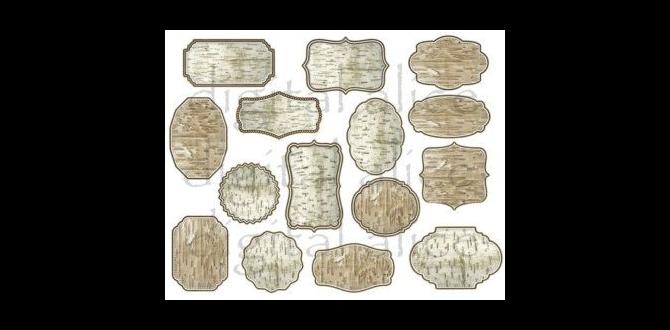Quick Summary:
Secure siding effectively using a nail gun by selecting the right tool and fasteners, setting it correctly to avoid damage, and following precise nailing techniques for a durable, attractive finish. This guide breaks down the process for DIY success.
Hey there, DIY friends! Jack Shaffer here, your go-to guy for all things nailers and woodworking. Ever look at a beautifully sided house and think, “Wow, that looks solid!”? A big part of that strength and beauty comes from how the siding is attached. And when you’re doing it yourself, a nail gun can be a total game-changer, saving you time and effort. But using one correctly for siding isn’t just about pulling a trigger; it’s about understanding the tools and techniques. We’ll walk through the whole process, from choosing your nail gun to getting that perfect, finished look. Let’s get your siding project looking pro!
Table of Contents
Why Use a Nail Gun for Siding?
Let’s face it, attaching siding piece by piece with a hammer can be a real marathon. It’s slow, physically demanding, and can lead to inconsistent results if you’re not a seasoned pro. This is where a nail gun steps in to make your life so much easier. It drives nails quickly and consistently, which is super important for keeping your siding straight and secure. Think about the sheer volume of nails needed for an entire house – a nail gun can cut down installation time dramatically. Plus, for many siding materials, the consistent depth of drive from a nail gun is crucial for preventing damage. We’re talking efficiency, speed, and a much better finished product, even for beginners.
Choosing the Right Nail Gun for Siding
Not all nail guns are created equal, and using the wrong one for siding can cause headaches. For most siding applications, you’ll want a specific type of nailer. The most common choice is an air-powered siding nailer. These are powerful and reliable, designed to handle the pressure needed to drive nails through various siding materials like wood, vinyl, or fiber cement. You might also hear about other types, but for siding, we’re usually looking at something that can handle longer nails consistently and with enough force.
Siding Nail Gun Types:
- Pneumatic Siding Nailers: These are the workhorses. They connect to an air compressor, providing the consistent power needed for tough materials. They are generally more powerful and durable for extensive projects.
- Cordless (Battery-Powered) Siding Nailers: These offer great portability and convenience. While some are powerful enough for siding, others might not have the same consistent driving power as pneumatic models, especially for harder materials. Check the specs carefully!
- Powder-Actuated Tools: These are technically not nail guns but use a small explosive charge to drive fasteners. They are typically used for concrete or steel, not standard siding installation on wood framing. We’ll stick to pneumatic and cordless for siding.
For most DIY siding projects, especially if you’re dealing with wood or fiber cement siding, a good quality pneumatic siding nailer is often the best bet. If you’re working on a smaller project or prefer the freedom of no cords, a high-performance cordless siding nailer could also work. Always check your siding manufacturer’s recommendations for nail type and size – this is key!
Essential Tools and Materials
Before you even think about firing up that nail gun, let’s make sure you have everything you need. Having all your tools and materials ready will make the installation process smooth and much less stressful. Think of it as prepping your workspace – it saves so much time and frustration down the line!
What You’ll Need:
- Siding Nail Gun: As discussed, the right type for your siding material.
- Air Compressor (if using pneumatic): Make sure it has enough CFM (cubic feet per minute) output to keep up with your nail gun.
- Air Hose and Fittings: A good quality hose that reaches your work area, along with proper connectors.
- Siding Nails: The correct gauge, length, and type (e.g., galvanized for exterior use) specified by your siding manufacturer. Using the wrong nails is a common mistake.
- Safety Glasses: This is non-negotiable! Always, always wear safety glasses.
- Work Gloves: To protect your hands.
- Measuring Tape: For precise placement.
- Level: To ensure courses of siding are straight and true.
- Chalk Line: For marking guide lines.
- Utility Knife and/or Shears: For cutting siding pieces.
- Caulk and Caulk Gun: For sealing joints and potential gaps.
- Ladder or Scaffolding: For reaching higher areas.
- Tack Hammer: For making small adjustments without firing the nail gun.
- Pencil: For marking.
It might seem like a lot, but having all these items on hand means you can focus on the job itself without stopping to find something. And remember, always check your siding manufacturer’s installation guide. They’ll have specific requirements for nails, spacing, and fastening to ensure your warranty stays intact and your siding performs as it should.
Safety First: Operating Your Siding Nail Gun
Safety is absolutely paramount when using any power tool, and a siding nail gun is no exception. These tools are powerful, and when used improperly, they can cause serious injury. Let’s go over the critical safety steps so you can work with confidence and keep yourself and others safe.
Key Safety Precautions:
- Read the Manual: Seriously, your nail gun’s manual is your best friend. It has specific operating and safety instructions for your model.
- Wear Safety Glasses: Always, without exception. Flying debris or nail fragments can cause severe eye damage.
- Never Point the Nail Gun at Anyone: Treat it like a loaded weapon. Point it only at the work surface.
- Keep Fingers Away from the Trigger and Nose: Don’t place your finger on the trigger unless you are actively firing a nail. Avoid touching the contact trip/nose to anything other than the intended surface.
- Understand the Trigger Mechanism: Most siding nailers have a “contact trip” or “bump fire” mode, meaning the nail fires when the nose is pressed against the surface and the trigger is held down. Make sure you know how yours works and why you’re pressing the trigger.
- Secure Your Workpiece: Ensure the siding material is stable before attempting to drive a nail.
- Be Aware of Your Surroundings: Make sure no one is behind the surface you are nailing into. Nails can sometimes go all the way through, especially with thinner materials or framing.
- Disconnect Power When Not In Use: For pneumatic nailers, disconnect the air hose. For cordless, remove the battery.
- Use Compressed Air Safely: When connecting or disconnecting the air hose, be aware that air can blow out. Don’t point the hose at yourself or others.
- Proper Grip: Always grip the tool firmly.
Getting comfortable with these safety practices will not only protect you but also ensure you feel more confident using the nail gun. A little caution goes a long way in preventing accidents and ensuring your project can be completed successfully.
Prepping for Siding Installation
Before you start driving nails, proper preparation is key. This stage ensures your siding will go on straight, stay put, and look its best. Rushing through prep work is a recipe for minor issues that can become big problems later on. So, let’s get our ducks in a row!
Steps for Preparation:
- Inspect the Wall Structure: Ensure the wall framing is sound, properly sheathed, and ready to receive siding. Address any issues like rot or damage before proceeding.
- Install Weather Barrier: A house wrap or other weather-resistant barrier (WRB) is crucial for protecting the wall structure from moisture. Make sure it’s installed correctly according to manufacturer instructions, overlapping seams and sealing edges. Learn more about common building wraps at the Building Science Information site.
- Mark Lines: Use a chalk line and level to mark horizontal lines on your WRB to guide the bottom edge of each siding course. This ensures your siding runs straight and level around the entire house. These lines typically represent the “reveal” or visible portion of each siding board.
- Check Stud Locations: While you don’t nail every siding piece directly into a stud (many siding types are designed to create a rainscreen effect), knowing where your studs are is generally helpful for planning. Some siding might require nailing into studs for specific applications or at critical points.
- Prepare Siding Materials: Unpack your siding and inspect it for any defects. Acclimatize wood siding materials to the climate on-site according to the manufacturer’s instructions. Cut pieces to length as needed, paying attention to expansion gaps for materials like wood or fiber cement.
- Set Up Your Nail Gun: Connect your air compressor (if pneumatic), set your desired pressure (more on this later), and load it with the correct siding nails. Ensure the magazine is clean and free of debris.
Taking the time here sets you up for success. Proper prep means fewer headaches during installation and a better-looking, more durable end result. You’re building a beautiful home exterior, and that starts with a solid foundation of preparation.
How to Secure Siding Using a Nail Gun: Step-by-Step
Alright, the moment you’ve been waiting for! With your tools ready, safety gear on, and walls prepped, it’s time to learn how to get those siding pieces secured properly with your nail gun. Remember, consistency is key here. We want nails driven to the right depth without damaging the siding.
Step 1: Calibrate Your Nail Gun (Depth Setting)
This is arguably the MOST important step. You need to set the depth your nail gun drives the fasteners. Too deep, and you’ll crush or split the siding material. Too shallow, and the nail won’t hold the siding securely, potentially allowing water ingress or bowing of the siding over time. Each siding material is different, and the nail gun might have adjustable depth settings.
- Test on Scrap Material: Find a few pieces of scrap siding material identical to what you’re installing.
- Start with a Moderate Pressure/Depth Setting: Set your air pressure on the compressor a bit lower than the maximum recommended by your nail gun manufacturer (often around 80-100 PSI, but check your tool’s manual). Adjust the depth setting on the nail gun itself to a mid-range setting.
- Drive a Nail: Press the nail gun’s nose against the scrap siding and pull the trigger.
- Inspect the Nail: Is it fully driven? Is the head slightly below the surface? Is the siding material around the nail head damaged, crushed, or split?
- Adjust and Test Again:
- If the nail head is sticking up, increase the depth setting slightly or the air pressure a little.
- If the nail head is driven too deep, crushing the siding, decrease the depth setting or air pressure.
- You’re aiming for the nail head to be just slightly sunk below the surface of the siding, or flush, depending on the siding type and manufacturer’s recommendation. This provides a clean look and prevents water from pooling around the nail head.
- Repeat until Perfect: Keep testing and adjusting until you achieve a perfect drive on your scrap pieces.
Pro Tip: For vinyl siding, you generally want the nail head to be slightly loose – you should be able to slide a fingernail under it. This allows for expansion and contraction. For wood or fiber cement, you’ll typically want it flush or slightly proud.
Step 2: Nailing Technique for Different Siding Types
The way you place and drive nails varies depending on the siding material. Following the manufacturer’s guidelines is always the best approach, but here are some general principles:
Wood Siding (Clapboard, Shingles, etc.):
- Fastener Type: Use galvanized or stainless steel nails to prevent rust streaks.
- Nail Length: Typically long enough to pass through the siding and penetrate the sheathing or studs by at least 1 to 1.5 inches.
- Nailing Location: For clapboard siding, nails should go through the face of the board and into the stud or sheathing. Some systems recommend blind-nailing through the tongue. Always nail through the thicker part of the board. Avoid nailing too low, which can cause the board to cup.
- Nail Spacing: Follow manufacturer recommendations, usually around 16 inches on center for studs, and specific spacing per course.
- Depth: Slightly countersunk, but not so deep that it crushes the wood fibers.
Fiber Cement Siding:
- Fastener Type: Corrosion-resistant nails (galvanized or stainless steel) are recommended.
- Nail Length: Usually 1.5 to 2.5 inches, depending on thickness and substrate.
- Nailing Location: Nail into studs whenever possible. The number of fasteners per board and their placement are critical.
- Depth: Flush or very slightly proud of the surface. Over-driving can crack the material.
- Expansion Gaps: Crucial! Manufacturers specify gaps at joints and the top of the wall.
Most fiber cement siding manufacturers, like those at James Hardie, provide very specific installation instructions, which are essential to follow for product performance and warranty.
Vinyl Siding:
- Fastener Type: Use galvanized steel, stainless steel, or aluminum nails.
- Nail Length: Typically 1.25 to 1.75 inches.
- Nailing Location: Nail into the nailing strip provided on the vinyl panel, into the sheathing or studs.
- Depth: This is where vinyl is unique. Nail heads should be snug but not tight. You should be able to slide a fingernail or a putty knife blade under the nail head. This allows the vinyl to expand and contract freely with temperature changes.
- Nail Spacing: Nails should be spaced about 12-16 inches apart.
- Avoid Over-Nailing: Do NOT nail vinyl siding tightly. It needs to move!
For a comprehensive look at building methods, the Fine Homebuilding Exteriors section offers excellent, detailed advice.
Step 3: Nailing Technique for Installation
Now for the actual nailing. Work from bottom to top, overlapping courses as you go.
- Position the Siding: Place your first (bottom) course of siding. Ensure it’s level and properly aligned. For subsequent courses, ensure they overlap the course below by the manufacturer’s specified amount.
- Hold the Nail Gun Firmly: Keep a good grip on the nail gun.
- Place the Nose: Position the nose of the nail gun squarely against the siding where you want to drive the nail. Ensure you are hitting the intended fastening point (e.g., into a stud, or at the proper spot on the siding’s nailing strip).
- Drive the Nail: As discussed, ensure your nail gun is set correctly for the siding material. Press the nose firmly against the siding and pull the trigger. The nail should drive in to the correct depth.
- Maintain Consistent Pressure: Apply steady pressure to the tool.
- Nail Spacing: Follow your material’s recommended spacing. Typically, you’ll place nails strategically along the length of each board, ensuring it’s held securely but allowing for movement where necessary (especially with vinyl).
- Corner and Trim Work: Use your nail gun for corners, around windows, and doors. You might need to use a tack hammer or a lower setting on your nail gun for these areas to avoid over-driving or splitting trim pieces.
- Blind Nailing: Some siding (like certain wood clapboards) can be blind nailed. This involves driving the nail at an angle through the overlapping part of the siding, so the nail head isn’t visible on the face of the installed siding. This offers a cleaner look. Your siding nailer might be equipped for this, or you might need to adjust your angle.
Step 4: Sealing and Finishing Touches
Once all your siding is installed, a few finishing touches will ensure it’s protected and looks complete.
- Caulk Joints: Apply a high-quality exterior caulk to all joints, seams, and around penetrations (windows, doors, vents). This is critical for preventing water from getting behind the siding.
- Inspect Nails: Check that all nail heads are driven to the correct depth. If any are sticking out, gently tap them down with a nail set and hammer (or even



